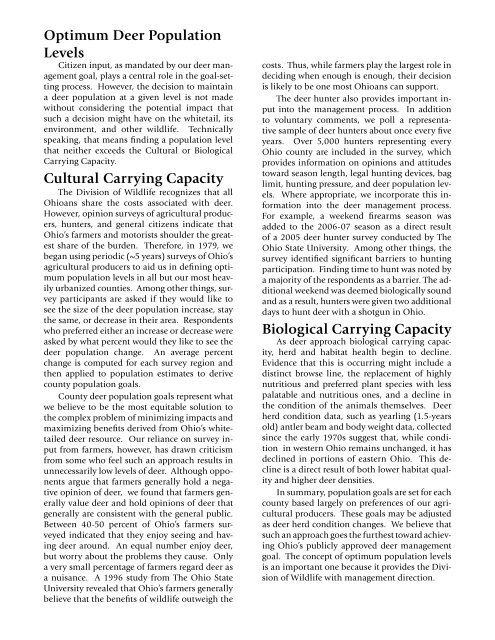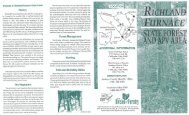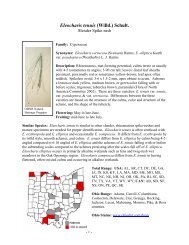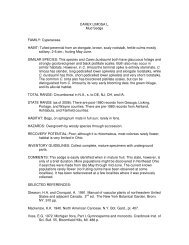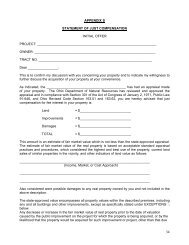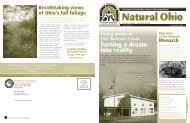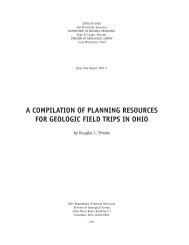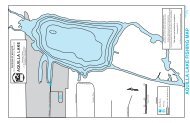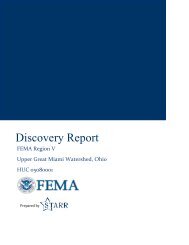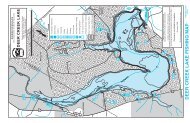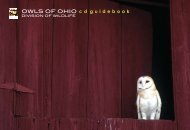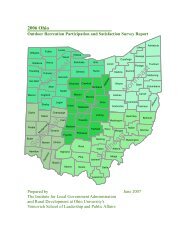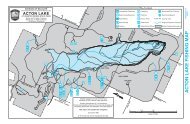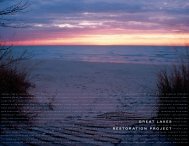Managing Ohio's Deer Herd - Ohio Department of Natural Resources
Managing Ohio's Deer Herd - Ohio Department of Natural Resources
Managing Ohio's Deer Herd - Ohio Department of Natural Resources
You also want an ePaper? Increase the reach of your titles
YUMPU automatically turns print PDFs into web optimized ePapers that Google loves.
Optimum <strong>Deer</strong> PopulationLevelsCitizen input, as mandated by our deer managementgoal, plays a central role in the goal-settingprocess. However, the decision to maintaina deer population at a given level is not madewithout considering the potential impact thatsuch a decision might have on the whitetail, itsenvironment, and other wildlife. Technicallyspeaking, that means finding a population levelthat neither exceeds the Cultural or BiologicalCarrying Capacity.Cultural Carrying CapacityThe Division <strong>of</strong> Wildlife recognizes that all<strong>Ohio</strong>ans share the costs associated with deer.However, opinion surveys <strong>of</strong> agricultural producers,hunters, and general citizens indicate that<strong>Ohio</strong>’s farmers and motorists shoulder the greatestshare <strong>of</strong> the burden. Therefore, in 1979, webegan using periodic (~5 years) surveys <strong>of</strong> <strong>Ohio</strong>’sagricultural producers to aid us in defining optimumpopulation levels in all but our most heavilyurbanized counties. Among other things, surveyparticipants are asked if they would like tosee the size <strong>of</strong> the deer population increase, staythe same, or decrease in their area. Respondentswho preferred either an increase or decrease wereasked by what percent would they like to see thedeer population change. An average percentchange is computed for each survey region andthen applied to population estimates to derivecounty population goals.County deer population goals represent whatwe believe to be the most equitable solution tothe complex problem <strong>of</strong> minimizing impacts andmaximizing benefits derived from <strong>Ohio</strong>’s whitetaileddeer resource. Our reliance on survey inputfrom farmers, however, has drawn criticismfrom some who feel such an approach results inunnecessarily low levels <strong>of</strong> deer. Although opponentsargue that farmers generally hold a negativeopinion <strong>of</strong> deer, we found that farmers generallyvalue deer and hold opinions <strong>of</strong> deer thatgenerally are consistent with the general public.Between 40-50 percent <strong>of</strong> <strong>Ohio</strong>’s farmers surveyedindicated that they enjoy seeing and havingdeer around. An equal number enjoy deer,but worry about the problems they cause. Onlya very small percentage <strong>of</strong> farmers regard deer asa nuisance. A 1996 study from The <strong>Ohio</strong> StateUniversity revealed that <strong>Ohio</strong>’s farmers generallybelieve that the benefits <strong>of</strong> wildlife outweigh thecosts. Thus, while farmers play the largest role indeciding when enough is enough, their decisionis likely to be one most <strong>Ohio</strong>ans can support.The deer hunter also provides important inputinto the management process. In additionto voluntary comments, we poll a representativesample <strong>of</strong> deer hunters about once every fiveyears.Over 5,000 hunters representing every<strong>Ohio</strong> county are included in the survey, whichprovides information on opinions and attitudestoward season length, legal hunting devices, baglimit, hunting pressure, and deer population levels.Where appropriate, we incorporate this informationinto the deer management process.For example, a weekend firearms season wasadded to the 2006-07 season as a direct result<strong>of</strong> a 2005 deer hunter survey conducted by The<strong>Ohio</strong> State University. Among other things, thesurvey identified significant barriers to huntingparticipation. Finding time to hunt was noted bya majority <strong>of</strong> the respondents as a barrier. The additionalweekend was deemed biologically soundand as a result, hunters were given two additionaldays to hunt deer with a shotgun in <strong>Ohio</strong>.Biological Carrying CapacityAs deer approach biological carrying capacity,herd and habitat health begin to decline.Evidence that this is occurring might include adistinct browse line, the replacement <strong>of</strong> highlynutritious and preferred plant species with lesspalatable and nutritious ones, and a decline inthe condition <strong>of</strong> the animals themselves. <strong>Deer</strong>herd condition data, such as yearling (1.5-yearsold) antler beam and body weight data, collectedsince the early 1970s suggest that, while conditionin western <strong>Ohio</strong> remains unchanged, it hasdeclined in portions <strong>of</strong> eastern <strong>Ohio</strong>. This declineis a direct result <strong>of</strong> both lower habitat qualityand higher deer densities.In summary, population goals are set for eachcounty based largely on preferences <strong>of</strong> our agriculturalproducers. These goals may be adjustedas deer herd condition changes. We believe thatsuch an approach goes the furthest toward achieving<strong>Ohio</strong>’s publicly approved deer managementgoal. The concept <strong>of</strong> optimum population levelsis an important one because it provides the Division<strong>of</strong> Wildlife with management direction.


